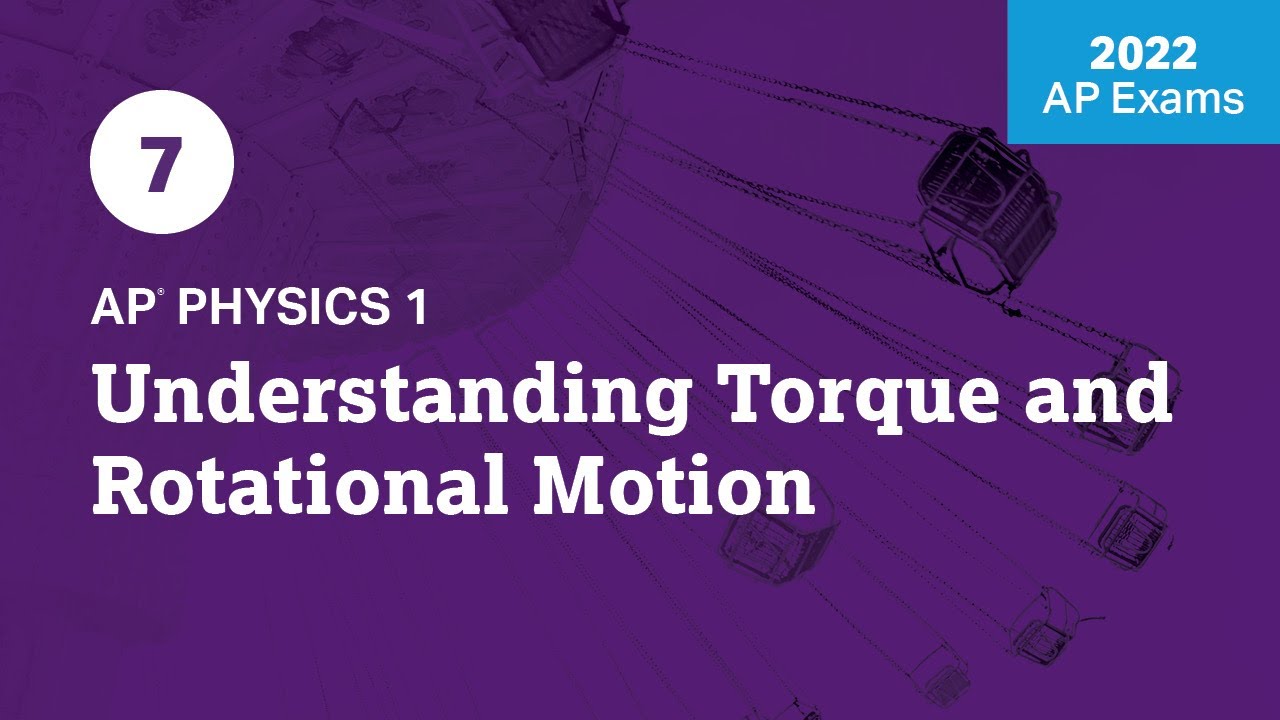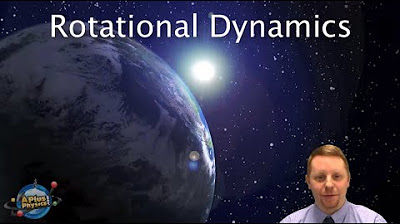AP PHYSICS 1: Unit 7 FRQ 1 (AP Classroom)
TLDRIn this physics classroom transcript, Mr. Heinrich discusses the forces and torques acting on a suspended sign in different scenarios. He analyzes the tension in the support cable when the sign is hung from various points and calculates the angular acceleration at different times during the sign's rotation. The transcript also covers the derivation of equations to model angular velocity and the interpretation of a graph showing angular velocity versus theta. The discussion is rooted in principles of equilibrium, torque, and rotational inertia, providing a comprehensive understanding of the physical phenomena at play.
Takeaways
- 📐 The problem involves a sign suspended from three different points (A, B, or C) with varying tension experienced by the support cable.
- ⚖️ Part A requires ranking the hook locations (A, B, C) according to the tension experienced by the cable, with A having the greatest tension due to the shortest lever arm.
- 🔄 The concept of equilibrium is central, with two conditions: net force equals zero and torques counterclockwise must equal torques clockwise.
- 🔩 In Part B, the sign rotates clockwise after the cable breaks, and the question is to determine if the angular acceleration changes at different times (T1, T2, T3) during the rotation.
- 🌀 Angular acceleration (α) is greatest at T1 because the component of gravity (mg sine theta) is largest at this point, and it decreases as the sign rotates to T2 and T3.
- 📈 Part C involves showing that α can be modeled with the equation α = (3mg sine theta) / (2LS), given the rotational inertia of the sign is 1/3 Ms LS^2.
- 📊 For Part D, the students propose an equation to describe the angular velocity (Ω) of the sign as a function of time, but the correct equation should match the data collected from sensors.
- 📉 The graph of angular velocity vs. theta shows a negative x-squared trend, indicating that the rate of increase in angular velocity decreases as the angle decreases.
- 🌐 The correct equation for Part D, based on the graph and analysis, is Ω = √(3g) cosine theta / LS, reflecting the tapering increase in angular velocity.
- 🔑 The key to solving the problem is understanding the relationship between torque, angular acceleration, and the lever arm's length, as well as the behavior of trigonometric functions like sine and cosine.
- 🎓 This analysis is based on concepts from AP Physics 1, Unit 7, and involves applying Newton's second law for rotational motion to real-world scenarios.
Q & A
What is the main topic of the video?
-The main topic of the video is the analysis of a physics problem involving the tension in a cable supporting a sign, and the angular acceleration of the sign as it rotates.
What are the three points from which the sign can be suspended, as mentioned in the script?
-The three points from which the sign can be suspended are points A, B, and C.
How does the mass of the sign and its length contribute to the problem?
-The mass of the sign (M) and its length (Ls) are crucial in calculating the tension in the support cable and the angular acceleration of the sign. They are used in the equations that describe the forces and torques acting on the sign.
What is the significance of the angle theta in this problem?
-The angle theta (θ) is the angle between the cable supporting the sign and the vertical axis. It is used to determine the component of the gravitational force acting as a torque, which influences the tension in the cable and the angular acceleration of the sign.
How does the location of the cable attachment affect the tension experienced by the cable?
-The location of the cable attachment affects the tension because the lever arm (distance from the pivot to the point where the force is applied) changes. A shorter lever arm at point A results in the greatest tension, while a longer lever arm at point C results in the least tension.
What are the two conditions for equilibrium in this problem?
-The two conditions for equilibrium are: the net force must be equal to zero (meaning the sum of upward and downward forces, and leftward and rightward forces, must balance), and the net torques counterclockwise must equal the torques clockwise.
How does the force of gravity contribute to the torque acting on the sign?
-The force of gravity (mg) acts on the sign and creates a torque when it is resolved into a component perpendicular to the lever arm (distance from the pivot). This torque tries to produce a clockwise rotation, which must be balanced by the counterclockwise torque from the tension in the cable.
What is the rotational inertia of the sign as given in the script?
-The rotational inertia (I) of the sign is given as 1/3 M_s Ls^2, where M_s is the mass of the sign and Ls is its length.
How does the angular acceleration of the sign change as it rotates?
-The angular acceleration (α) of the sign decreases as it rotates. This is because the net torque causing the angular acceleration, which is mg * sine(theta) times the radius, decreases as the angle theta decreases during the rotation.
What is the proposed equation for the angular velocity of the sign as a function of time in Part C?
-The proposed equation for the angular velocity (Omega) of the sign as a function of time is Omega = (3 * G * sine(theta)) / (2 * Ls) * t. However, this equation does not make physical sense as it implies a constant rate of increase in angular velocity, which is not the case.
Which equation best matches the data collected in the graph presented in Part D?
-The equation that best matches the data collected is Omega = sqrt(3 * G * cosine(theta) / Ls), as it correctly represents the decreasing rate of increase in angular velocity as the sign rotates through different angles.
Outlines
📚 Physics Classroom: Tension in a Suspended Sign
This paragraph discusses a physics classroom scenario where a sign is suspended from three different points, A, B, and C, and the tension experienced by the support cable at each point is analyzed. The concept of equilibrium, both in terms of net force and torque, is introduced. The analysis focuses on the impact of the lever arm and the angle theta on the tension at each point, concluding that the tension is greatest at point A due to the shortest lever arm.
🔄 Angular Acceleration during Sign Rotation
The paragraph delves into the angular acceleration of a sign that rotates when its supporting cable breaks. The analysis involves examining the force causing the rotation, the torque produced, and how it changes at different points during the rotation. It is concluded that the angular acceleration is greatest at the initial point (t1) because the component of gravity (mg sine theta) is largest at that point, and it decreases as the sign continues to rotate to t2 and t3.
📝 Deriving the Equation for Angular Acceleration
This section focuses on deriving the equation for angular acceleration (alpha) using the given information about the sign's mass, length, and angle theta. The rotational inertia of the sign is identified, and Newton's second law for rotational objects is applied to find the net torque. The derived equation relates alpha to the gravitational force, sine theta, and the lever arm, leading to the equation 3G sine theta divided by 2LS for alpha.
📊 Evaluating the Proposed Angular Velocity Equation
The paragraph examines a proposed equation for the angular velocity (Omega) of the rotating sign as a function of time. It is determined that the equation does not make physical sense as it implies a constant rate of increase in angular velocity, which contradicts the actual decreasing rate of angular acceleration. The analysis highlights the importance of understanding the physical implications of mathematical models.
📈 Matching the Motion Equation to Experimental Data
This part discusses the comparison of several proposed equations with experimental data collected on the angular velocity versus theta of the rotating sign. The analysis focuses on the initial conditions and the behavior of the system as theta changes. It is concluded that the equation Omega equals the square root of three G cosine theta divided by LS best matches the data, reflecting the decreasing rate of angular acceleration as the sign swings down.
🔄 Understanding the Relationship between Theta and Angular Velocity
The final paragraph provides insight into the relationship between the angle theta and the angular velocity of the sign. As theta decreases, the cosine of theta increases, which in turn affects the rate of increase in Omega. The explanation emphasizes that while the increase in Omega is initially rapid, it tapers off due to the square root function and the increasing cosine of theta, reflecting the graph's shape and the physical behavior of the system.
Mindmap
Keywords
💡Tension
💡Equilibrium
💡Torque
💡Angular Acceleration
💡Rotational Inertia
💡Gravitational Force
💡Hooke's Law
💡Newton's Second Law
💡Angular Velocity
💡Trigonometry
Highlights
Analysis of the tension in a support cable suspending a sign at different points (A, B, C) based on the angle theta and the equilibrium conditions.
Determination of the greatest tension point (point A) by considering the torque balance and the lever arm's length.
Explanation of how the angular acceleration changes as the sign rotates, with the force of gravity (mg) and its components playing a key role.
Discussion on the net torque and its relationship with angular acceleration, emphasizing the importance of the perpendicular force component.
Derivation of the angular acceleration (alpha) using Newton's second law for rotational motion and the given rotational inertia.
Evaluation of a proposed equation for angular velocity (Omega) as a function of time, highlighting the incorrect assumption of a direct proportionality between time and angular velocity.
Explanation of why the proposed equation for Omega does not make physical sense, as the rate of increase in angular velocity decreases over time.
Presentation of actual data collected from sensors tracking the sign's angular velocity versus theta, and the task of identifying the equation that best matches the data.
Discussion on the selection of the correct function (cosine vs. sine) for modeling the relationship between angular velocity and angle theta, based on the observed data and the physical understanding of the system.
Identification of the correct equation for Omega as a function of theta, which is rooted in the cosine function and the physical behavior of the system.
Explanation of how the increase in angular velocity tapers off as theta decreases, mirroring the behavior of the cosine function.
The problem setup involves a sign suspended from a cable, with the goal of ranking the hook locations (A, B, C) according to the tension experienced by the cable.
The sign's rotation is caused by the force of gravity acting on it, and the torque produced by this force is crucial for determining the angular acceleration.
The rotational inertia of the sign is given as 1/3 M_s L_s^2, which is used in the derivation of the angular acceleration equation.
The analysis of the system involves both static equilibrium conditions and rotational dynamics, as the sign moves from one position to another.
The angular acceleration is not constant due to the changing torque caused by the varying angle theta and the force of gravity's component.
The task includes evaluating the physical plausibility of proposed equations and selecting the one that best describes the sign's motion based on empirical data.
Transcripts
Browse More Related Video

College Physics 1: Lecture 25 - Moment of Inertia and Rotational Dynamics

2022 Live Review 7 | AP Physics 1 | Understanding Torque and Rotational Motion

AP Physics 1 - Rotational Dynamics

Angular Momentum - Basic Introduction, Torque, Inertia, Conservation of Angular Momentum

Rotational Motion

Rotational Equilibrium Introduction (and Static Equilibrium too!!)
5.0 / 5 (0 votes)
Thanks for rating: